
The United States Coast Guard (USCG) is the maritime security, search and rescue, and law enforcement service branch of the United States Armed Forces and one of the country's eight uniformed services. The service is a maritime, military, multi-mission service unique among the United States military branches for having a maritime law enforcement mission with jurisdiction in both domestic and international waters and a federal regulatory agency mission as part of its duties. It is the largest coast guard in the world, rivaling the capabilities and size of most navies.

Edwin John Roland, was a United States Coast Guard admiral and served as the twelfth Commandant of the Coast Guard from 1962 to 1966. During his tenure, Roland oversaw the replacement of many World War II era cutters under fleet modernization programs. He also assisted the U.S. Navy with operations in Vietnam by supplying crews and cutters for Operation Market Time. Roland was noted for his support in efforts to bring international safety standards to merchant shipping. Although Roland was already retired when the Coast Guard was transferred from the Department of Treasury to the newly formed Department of Transportation in 1967, he was largely responsible for the planning for the move and the Coast Guard retaining its military responsibilities along with its transportation related functions.
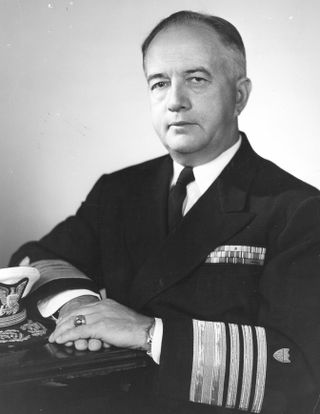
Alfred Carroll Richmond was an admiral of the United States Coast Guard who served as the 11th Commandant of the United States Coast Guard from 1954 to 1962, the second longest tenure of any U.S. Coast Guard Commandant following Russell R. Waesche who served from 1936 to 1946.

Merlin O'Neill served as the tenth Commandant of the United States Coast Guard from 1 January 1950 to 1 June 1954.
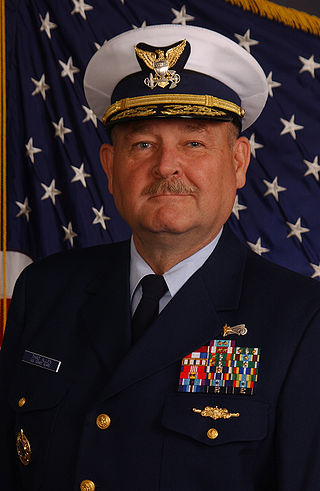
Thad William Allen is a former admiral of the United States Coast Guard who served as the 23rd commandant from 2006 to 2010. Allen is best known for his widely praised performance directing the federal response to hurricanes Katrina and Rita in the Gulf Coast region from September 2005 to January 2006, and for his role as National Incident Commander of the Unified Command for the Deepwater Horizon oil spill in the Gulf of Mexico in 2010. Robert J. Papp Jr. succeeded him as Commandant on 25 May 2010.
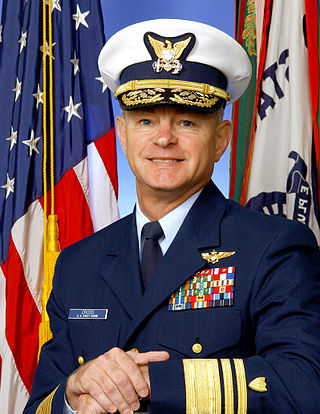
Terry M. Cross is a retired United States Coast Guard Vice Admiral who served as Vice Commandant of the United States Coast Guard from July 2004 until June 2006. He served as the Coast Guard's second in command and was the Agency Acquisition Executive.
This article covers the organization of the United States Coast Guard.

Admiral Robert Joseph Papp Jr. is a retired admiral of the United States Coast Guard who served as the 24th commandant from 2010 to 2014. He led the largest component of the United States Department of Homeland Security, with 42,000 active duty, 8,200 Reserve, 8,000 civilian, and 31,000 Auxiliary personnel.
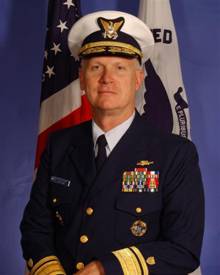
Timothy Shawn Sullivan is a retired rear admiral in the United States Coast Guard who served as the Deputy Commander, Pacific Area Coast Guard Defense Forces West. He was assigned as Commander of the Pacific Maintenance and Logistics Command, but was detached from those duties while serving as Deputy PACAREA. He has also served as the First Coast Guard District Commander and Commander, Maritime Defense Command One as well as the Senior Military Advisor to the Secretary of Homeland Security serving as the primary coordinator between the Departments of Defense and Homeland Security as well as operational advisor to the Secretary during Hurricanes Katrina and Rita.
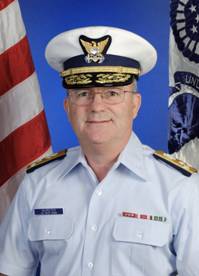
Charles D. Wurster is a retired vice admiral in the United States Coast Guard who last served as the Commander, Pacific Area and Commander, Defense Force West. He is now retired from the Coast Guard, is the President/CEO of the Port of San Diego, and serves as national commodore of the Sea Scouting division of the BSA.

Ronald James Rábago is a retired United States Coast Guard rear admiral who in 2006 became the first person of Hispanic American descent to be promoted to flag rank in the United States Coast Guard. He retired as the assistant commandant for engineering and logistics and the United States Coast Guard's chief engineer in 2014.

America's Waterway Watch (AWW) is a program of the United States Coast Guard and its Reserve and Auxiliary components to encourage members of the public to be on the alert for suspicious behavior by boaters. As part of an effort to tighten security after the September 11 attacks of 2001, people involved in the maritime industry and recreational boating were encouraged by the Coast Guard to report suspicious activity to the National Response Center. In 2005, Coast Guard Commandant Thomas H. Collins issued Commandant Instruction 16618.8, formalizing the program as America's Waterway Watch.
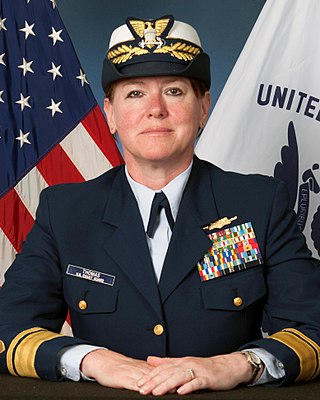
Cari Batson Thomas is a retired rear admiral of the United States Coast Guard and a 1984 graduate of the U. S. Coast Guard Academy. On January 22, 2010, Thomas became the third female commander of USCG Training Center Cape May to be advanced to a flag officer. Her final assignment was Assistant Commandant for Human Resources at the Coast Guard Academy.
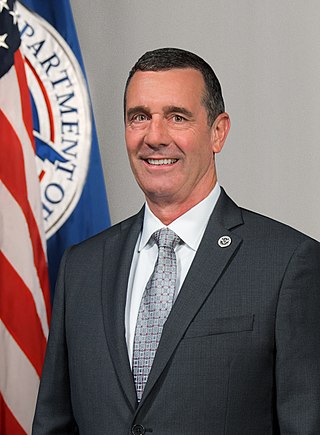
David Peter Pekoske is an American government official and retired U.S. Coast Guard vice admiral who has served as the seventh administrator of the Transportation Security Administration in the United States Department of Homeland Security (DHS) since 2017. He served as the acting deputy secretary of Homeland Security from April to November 2019 and again from January to June 2021. From January 20, 2021 to February 2, 2021 he served as acting secretary of homeland security, during the Senate confirmation of Alejandro Mayorkas. Pekoske retired with 33 years of active military service in 2010 as the 26th vice commandant of the Coast Guard.

Paul Frederick Zukunft is a retired admiral of the United States Coast Guard who served as the 25th commandant. He was confirmed by the U.S. Senate as the Commandant, with the rank of admiral, in May 2014 and relieved Robert J. Papp Jr. as commandant on 30 May 2014. Prior to his selection as Commandant, he served as Commander, Coast Guard Pacific Area. In this position, Zukunft was the operational commander for all U.S. Coast Guard missions within the half of the world that ranges from the Rocky Mountains to the waters off the East Coast of Africa. He concurrently served as Commander, Defense Force West and provided U.S. Coast Guard mission support to the U.S. Department of Defense and Combatant Commanders.
Hispanics in the United States Coast Guard can trace their tradition of service to the early 19th century, when they initially performed duties at light house stations as keepers and assistant keepers in its predecessor services. Hispanic is an ethnic term employed to categorize any citizen or resident of the United States, of any racial background, of any country, and of any religion, who has at least one ancestor from the people of Spain or is of non-Hispanic origin, but has an ancestor from Mexico, Puerto Rico, Cuba, Central or South America, or some other Hispanic origin. The three largest Hispanic groups in the United States are the Mexican-Americans, Puerto Ricans, and Cubans.
Captain Charley L. Diaz is a 30-year United States Coast Guard veteran who served on Active Duty from 1982 to 2012. Diaz is best known for leading the crew of the USCGC Sherman (WHEC-720) in the seizure of the Panamanian freighter GATUN off the coast of Panama in March 2007, which netted nearly 20 tons of cocaine worth an estimated $600 million. It was the largest maritime drug bust in US history.

Charles David Michel is a former United States Coast Guard admiral who last served as the 30th vice commandant of the U.S. Coast Guard. He is the first vice commandant to hold the rank of admiral while in office. Originally a vice admiral when he assumed office on August 6, 2015, Michel was promoted to four-star admiral on May 24, 2016 when the Coast Guard Authorization Act of 2015 elevated the statutory rank for the position to admiral. Michel is also the first career judge advocate in any of the armed forces to achieve four-star rank. Michel retired from the Coast Guard on May 24, 2018 after over 33 years of service.

Karl Leo Schultz is a retired United States Coast Guard admiral who served as the 26th Commandant of the Coast Guard from 2018 to 2022.

Charles W. Ray is a retired United States Coast Guard admiral who served as the vice commandant of the Coast Guard from May 24, 2018 to June 18, 2021. He previously served as the Coast Guard's deputy commandant for operations.




















